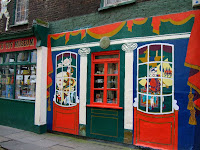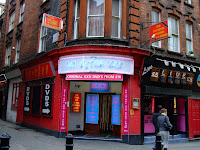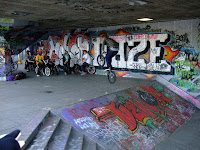 know an area you can always find that if you turn right instead of left you will find a whole different world that you never realised was there.
know an area you can always find that if you turn right instead of left you will find a whole different world that you never realised was there.Such was our experience on Saturday when we left Goodge St Station. It is on Tottenham Court Rd, just up from Oxford St, what else is there to know?
 Well, the Pollock’s Toy Museum for starters. Tucked around the back, in a couple of old buildings (one with it’s original 1760s’ interiors) is an amazing collection of old toys, dolls, bears, games and so on. Benjamin Pollock was one of the last producers of theatre scenes for two theatres – all hand painted. A toyshop remains to this day and the museum is a rabbit warren of stairs and rooms that spans the two buildings.
Well, the Pollock’s Toy Museum for starters. Tucked around the back, in a couple of old buildings (one with it’s original 1760s’ interiors) is an amazing collection of old toys, dolls, bears, games and so on. Benjamin Pollock was one of the last producers of theatre scenes for two theatres – all hand painted. A toyshop remains to this day and the museum is a rabbit warren of stairs and rooms that spans the two buildings.

Across the bustle of Oxford St one is quickly in Soho Square, a hundred years older than the building we had just left but no longer home to the aristocrats who first built there and soon you are in the middle of the sleaze area of London. As well as being home to some in the oldest profession it is home to Lina Stores, a grocery store that looks unchanged, inside an out, from the early 20th C.


Around the corner is a complete change as you enter Chinatown, bedecked with lanterns for the imminent Chinese New Year celebrations.
 A couple more corners and it is Leicester Square, home of the movie premieres but, sadly, no longer home to the mechanical clock on the Swiss Centre. The building that housed it has been demolished. Will the glockenspiel clock that had been there for over 20 years, return?
A couple more corners and it is Leicester Square, home of the movie premieres but, sadly, no longer home to the mechanical clock on the Swiss Centre. The building that housed it has been demolished. Will the glockenspiel clock that had been there for over 20 years, return? By now the National Gallery and Trafalgar Square are just around the corner and something that we have walked past dozens of times takes on a new significance. The little round construction close to the Tube entrance was once Britain’s smallest Police Station. There may have been room for the Bobby to turn around inside once he had entered but it would be a close run thing.
By now the National Gallery and Trafalgar Square are just around the corner and something that we have walked past dozens of times takes on a new significance. The little round construction close to the Tube entrance was once Britain’s smallest Police Station. There may have been room for the Bobby to turn around inside once he had entered but it would be a close run thing.
















































